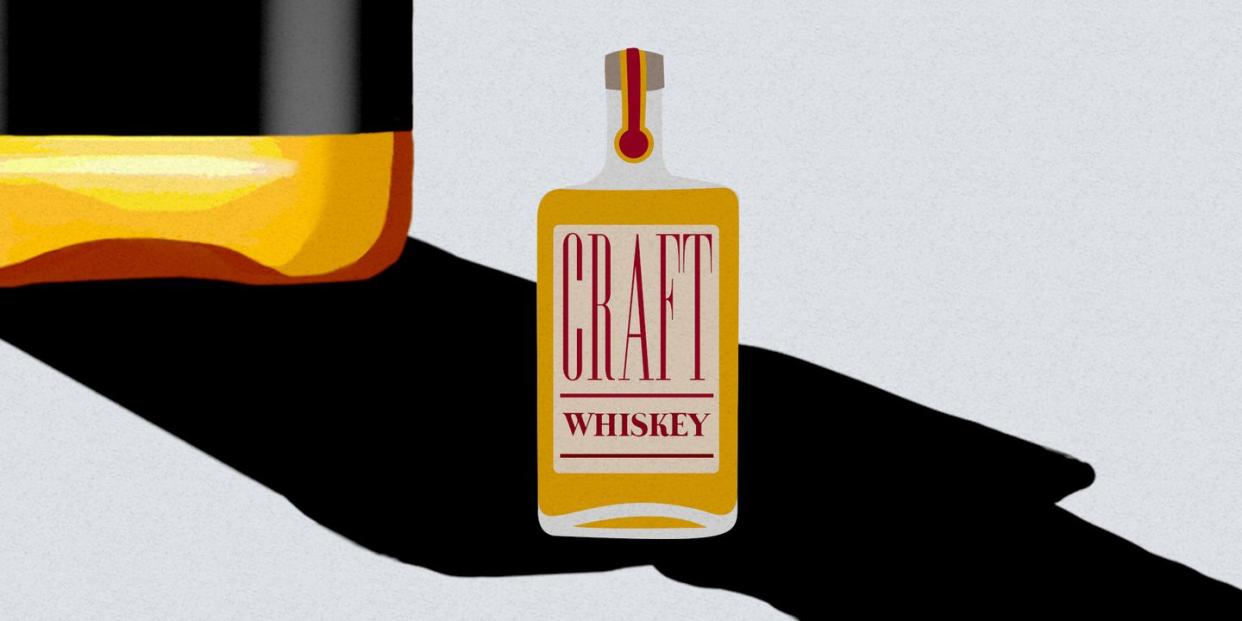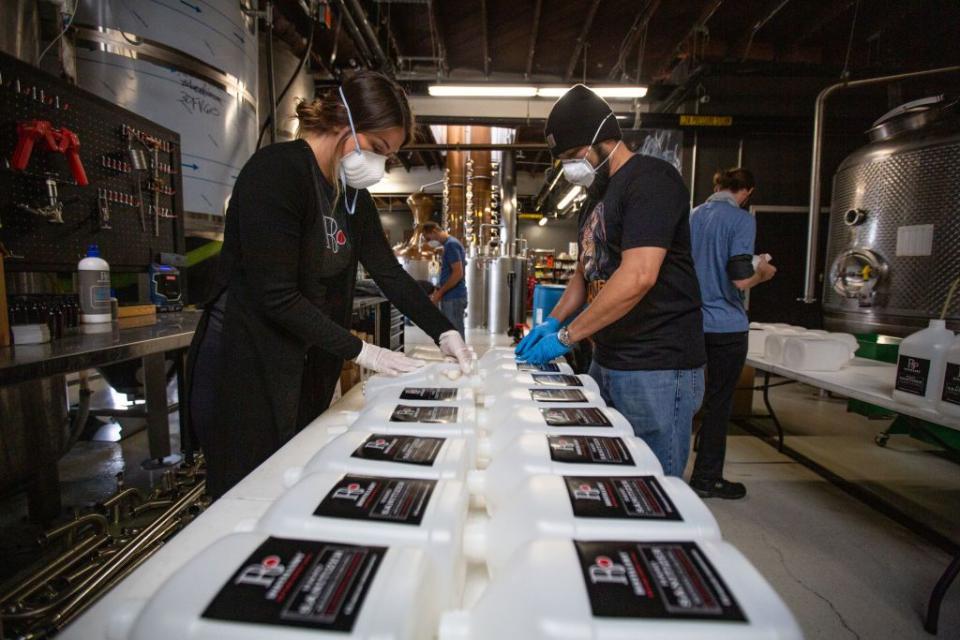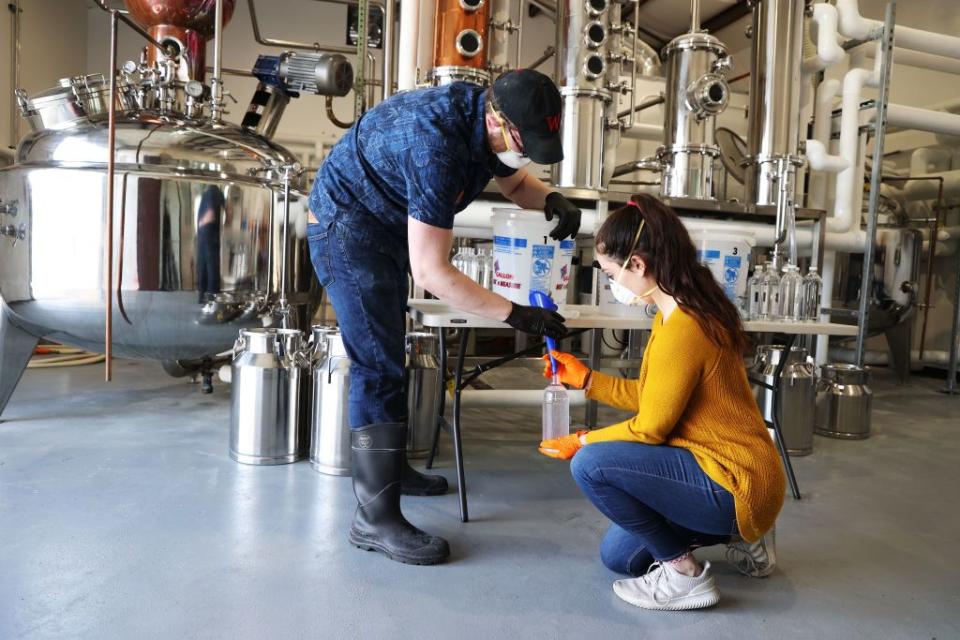As We All Turn to ‘Comfort’ Booze, Craft Distilleries Are Fighting for Survival

Here’s a depressing thought, at a time when we really don’t need any more depressing thoughts: We could be barreling towards a big-box booze future. Dire predictions abound that only chain restaurants and monolithic brands—the Applebee’s and Targets—will make it through this pandemic as independent restaurants flail. Similarly, it’s safe to say the dominant corporate distilleries like Jim Beam, Wild Turkey, and Jack Daniel’s, all of which produce high quality and affordable whiskey, will survive just fine.
Alongside the big guys, though, there are around two-thousand craft distilleries in the U.S. making any and every type of alcohol you can imagine—bourbon, single malt, rye, rum, gin, vodka, even malört, for some reason—that bring much-needed, small-batch diversity to liquor stores. I know I would rather drink in a world where I can go choose between a young peated bourbon distilled in Brooklyn, an amaro made in the Rocky Mountains using local botanicals, and some good old Kentucky whiskey. This just might not be an option a year from now.

In early March, Catoctin Creek co-founder Scott Harris excitedly wrote on his Virginia distillery’s website about the approach of St. Patrick’s Day, a new pug christened the "minister of cuteness," and bottling workshops for the public. A few weeks later, he would describe how "the whole rug has been pulled" out from under his feet. "The sales and tasting room staff that would have been furloughed were redirected to work sanitizer, so no impact for now to whiskey production," he wrote in an email to me in April. "It's crazy busy here, but we're holding it together." In the months since, hand sanitizer production ended, as the distillery found it impossible to obtain ingredients, but Harris managed to keep his staff employed filling orders. The tasting room reopened at half-capacity. Things were slowly starting to rebound.
But a new crisis-inspired report from the Distilled Spirits Council out this week provides some bleak statistics. Based on a June survey of almost 300 distilleries around the country, it revealed that craft distilleries are projected to lose $700 million in sales due to tasting room shutdowns and loss of onsite purchases, which represents 41 percent of their business. Nearly a third of craft distillery employees have been furloughed. It’s unclear how sustainable any rebound might be.
Distilleries are tourist attractions, and as the pandemic barrels through August, people aren’t traveling. While some tasting rooms have reopened in a limited, outdoor capacity, others remain shuttered. Those craft distilleries that stepped up to produce hand sanitizer instead of (or in addition to) spirits did so in a remarkable surge of altruism that bested profits for some, who donated to hospitals and fire departments. There’s even talk of distilleries being converted into vaccine production centers in the coming year. This might be a great idea for the continued survival of humankind, but it doesn’t really seem like a tenable business plan. And while we are still drinking (a lot) at home, causing online alcohol sales from websites like Drizly and Flaviar to soar, for craft distilleries, the benefits of this booze boom are a mixed bag.
One problem is that many people are turning to what New York Distilling Company owner Allen Katz calls "comfort brands"—those familiar booze heavyweights. "It’s a challenge, but it doesn’t make me cower," he said. In the midst of cranking out hand sanitizer to be donated, his distillery has been reaching drinkers through virtual tours, tastings, and online shops. "But ultimately," he said, "it’s up to the consumer to stay in their comfort zone or experiment with something new."
Besides name recognition, the "comfort" distilleries have resources behind them that don’t compare to the craft world. When I reached out to Four Roses in April to ask about the pandemic’s effect on production, master distiller Brent Elliott said that he was confident the September release of the annual Limited Edition Small Batch bourbon would not be delayed; representatives for Buffalo Trace and Jim Beam likewise confirmed everything remained on track. Craft distillers don’t feel quite as confident.
Brad Estabrooke, founder of Brooklyn's Breuckelen Distilling, says his limited resources will make the coming year very difficult, vaccine or no. And it’s not just a money issue; many small distilleries operate with a skeleton crew of devoted employees who may not want to or be allowed to go to work. "I don't think many small distilleries have the 'bench' to step in if the main folks get sick," Estabrooke said back in April. "I think part of the difficulty, probably for everyone, is trying to run the business and reduce risk at the same time."
In early August, Estabrooke told me that he’d been working at the distillery by himself all summer, after his assistant was called up to the National Guard as the pandemic exploded in New York City. "I could certainly use some help, but it's also difficult to train a new person while social distancing," he said in an email. "I've been quite concerned with reducing the spread and staying healthy myself. I guess so far I've been thinking it is easier to just hunker down and do the work myself." Overall, Breuckelen's sales have been down about 15 percent compared to last year, which is better than expected. Now, Estabrooke fears that his latest release, Brownstone Malt Whiskey, will suffer because customers won’t be able to come in to actually taste it onsite. "That's generally our best marketing for a new product," he said.
Selling craft spirits often involves a personal touch that bigger brands don’t need. At this point, most of us aren’t concerned with the backstory behind Jack Daniel’s (though there’s plenty of interesting history there). But if you are spending $60 on a two-year-old bottle of whiskey from an upstart distillery that has yet to make a name for itself, you are probably interested in hearing about the personalities, history, barrels, and mashbills behind it. People are thirsty for spirits that they can latch onto both for uniqueness and a sense of pride in a local business making good. The pandemic could sweep aside a new release, especially when tasting rooms are closed, adding another nail in the coffin for a craft producer.

Half a year into the pandemic, online sales remain the best (and sometimes only) way to get craft spirits into the hands of craft spirit drinkers, especially under threat of successive waves of the virus. Dan Leese, president and CEO of San Francisco’s Hotaling & Co., said that in addition to selling through online channels, Hotaling is focused on adding online educational experiences—like tasting mats with descriptions of various spirits, distiller interviews, and cocktail demonstrations—accompanied by links to "buy now."
Not every distillery has the funds or staff to urge consumers towards online sales, though. The phone at Nevada’s Frey Ranch Distillery was ringing off the hook with interested customers, according to co-founders Colby and Ashley Frey, and initially they had to refer them to the liquor stores that remained open. In May, their whiskey became available for online purchase. The good news is that many states have made changes to allow distilleries to ship directly to consumers. Tom Mooney, co-founder and CEO of Westward Whiskey in Oregon, saw growth of more than 30 percent compared to last year when Westward began mailing whiskey bottles straight to drinkers, a whiplash change. "It has done nothing short of saving our business," he wrote in an email.
If any craft distilleries don't make it to the other side of this pandemic, it won't be without dedicating boundless energy to ensuring that we continue to have drinking alternatives to the big brands. After all, it’s what we want. "Our taste buds have matured and evolved," said Katz. "There’s a mix of big brands and craft brands that have all garnered attention at the consumer level. Just because we’ve lived through this pandemic, I don’t believe our taste buds will change."
It might not be enough. In the latest punch to the gut, the federal government announced that it will maintain a 25 percent tariff on whiskey and other spirits imported from Europe, which has resulted in retaliatory tariffs on American whiskey. The Distilled Spirits Council says U.S. whiskey exports have fallen by 33 percent since the tariff was enacted. And according to Margie Lehrman, CEO of the American Craft Spirits Association, federal excise taxes on craft distilleries may increase by 400 percent if relief is not extended at the end of the year. "From the possibility of taxes rising, to tasting rooms shuttering, to the inability to even introduce spirits to consumers because of a market saturated with big brands on the shelves of retail stores," she said, "craft distillers face an uphill battle and a difficult future." As seems to be the running theme here, the outlook remains murky.
Estabrooke is trying to keep a hopeful attitude. "Distillers are a resilient, hardworking, and dedicated bunch," he said. "I'm generally amazed at how many continue to operate, because it takes a ton of hard work, and plenty of luck, to keep things going." If the tenacious energy behind our beloved craft spirits can persist, some distilleries may emerge from the pandemic stronger, or at least intact. We know the big booze players aren’t going anywhere, and there will be no shortage of Fireball, Tito’s, or Bulleit anytime soon. But if "comfort" booze is all we’ll have left, and that’s not very comforting at all.
You Might Also Like

